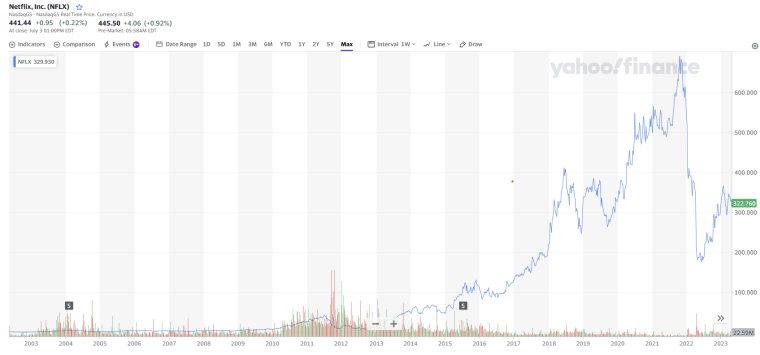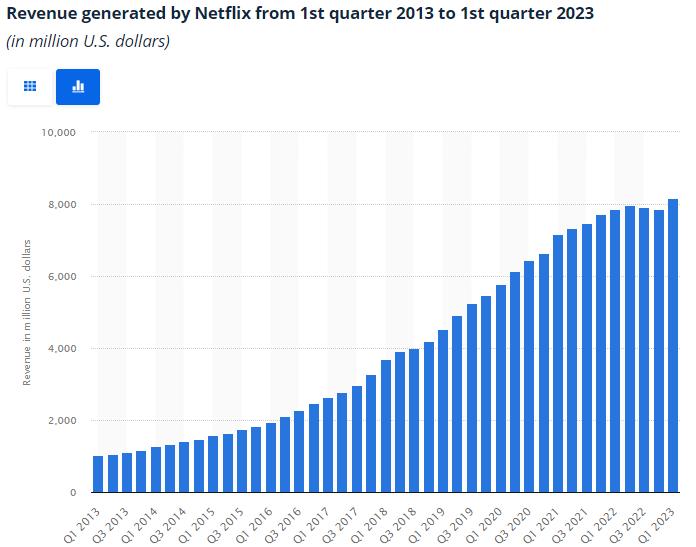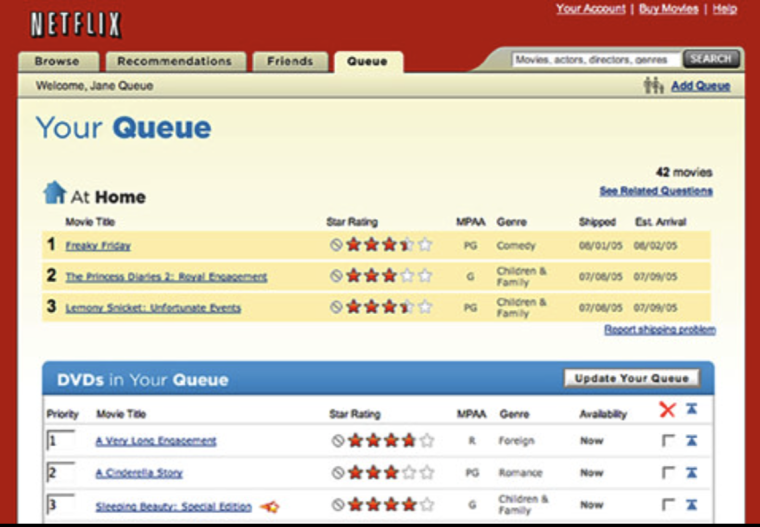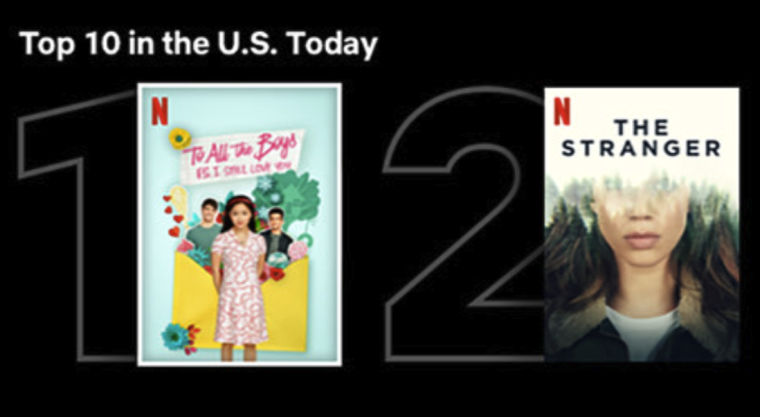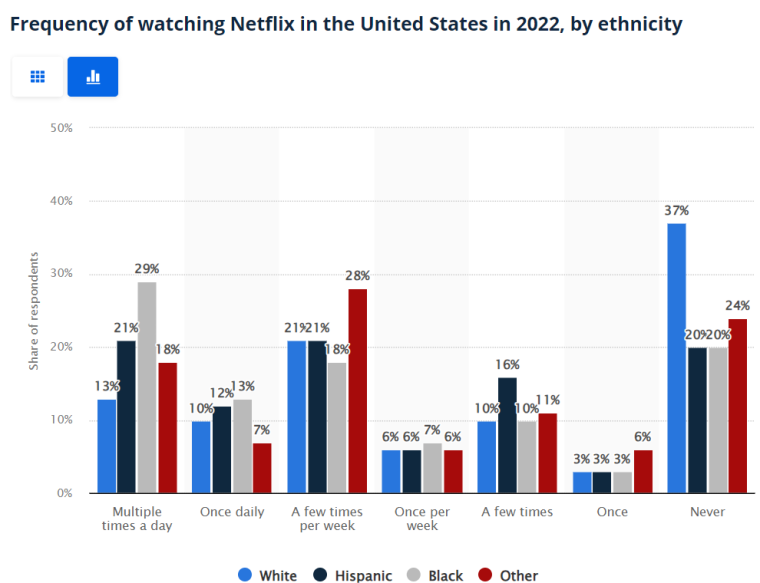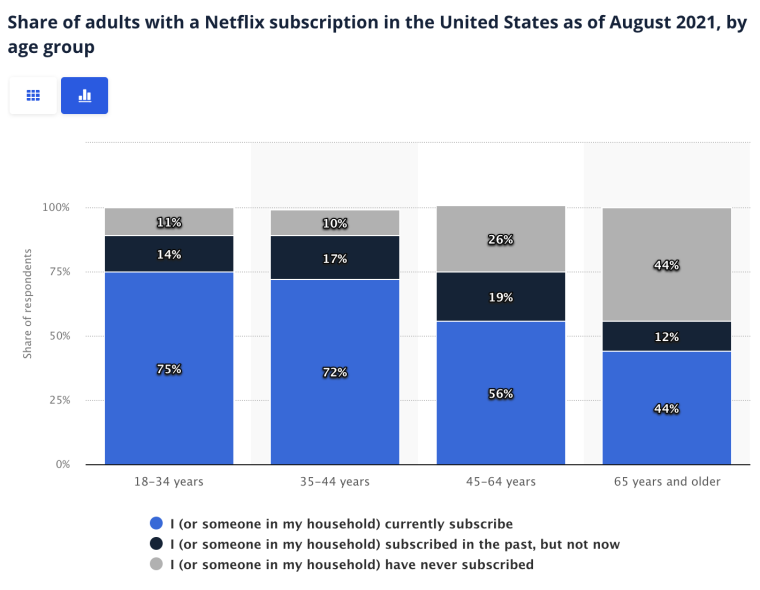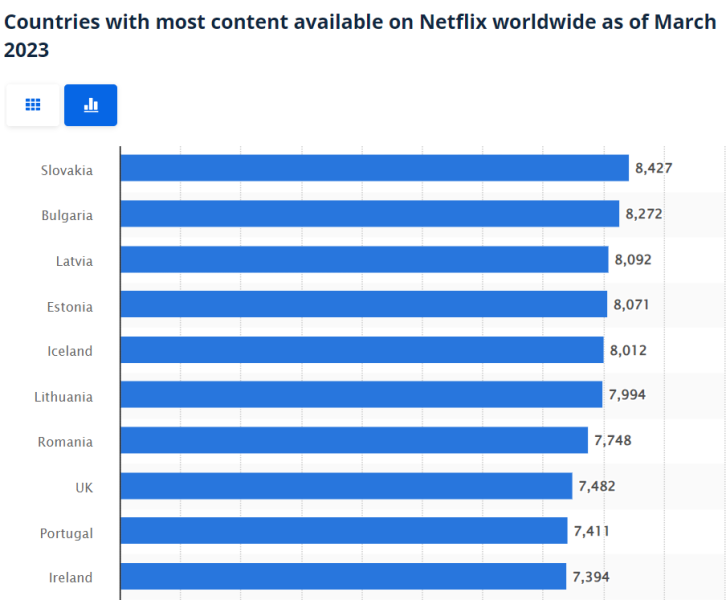In today’s digital age, the entertainment industry has witnessed a significant shift towards online streaming platforms, and Netflix has emerged as a powerhouse in this domain. As one of the leading streaming services globally, Netflix has revolutionized the way we consume content, captivating millions of subscribers worldwide.
This article provides a comprehensive overview of the company’s history, with a focus on revenue, products, and more. Whether you’re an industry enthusiast, investor, or simply curious about the streaming giant, these Netflix statistics offer a compelling glimpse into the company’s triumphs and achievements.
Netflix went public on May 23, 2002, offering shares at a price of $15 per share. Their name appears as NFLX on NASDAQ. In October 2011, Netflix’s stock price plummeted by around 35%. The major sell-off occurred due to a combination of factors, including the company’s decision to separate its DVD rental and streaming services. Near the beginning of 2013, the company’s stock price surged by 42%. The price bump was due to a quickly expanding subscriber base and its original content gaining traction. In July 2019, Netflix issued a revenue warning, reporting lower-than-expected subscriber growth, leading to a decline in its stock price by approximately 10.3% in a single day. This was attributed to regional price increases and a lack of new original content. Netflix has invested in three companies: Netflix has acquired a total of 9 companies: As of the first quarter of 2023, Netflix’s global paid subscriber count reached approximately 232.5 million. From the previous quarter, this reflected a growth of 1.75 million subscribers. Netflix introduced an ad-supported tier in November 2022 to counter losses in its subscriber base during the first half of 2022. A survey conducted in October 2022 indicated that approximately one-third of US Netflix subscribers expressed interest in switching to the ad-supported tier. In the first quarter of 2023, Netflix experienced an increase in revenue, reaching nearly $8.16 billion, up from approximately $7.9 billion in the last quarter of 2022. This growth trend aligns with Netflix’s year-on-year revenue growth over the past decade, with its annual revenue in 2022 totaling around $31.6 billion. During the COVID-19 pandemic, nearly 16 million individuals signed up for Netflix accounts within the initial three months of 2020. The hike in subscribers was due to confinements and lockdowns that caused people to seek entertainment. The largest number of new subscribers, totaling nearly 7 million, came from Europe, the Middle East, and Africa. There was also a surge in growth in the US and Canada, which had been slower in recent quarters, with 2.3 million new members joining the service, compared to only 550,000 in the final months of 2019. Netflix reported a revenue increase to $5.76 billion, marking a growth of over 27% compared to the same period in 2019. Profits almost doubled, rising from $344 million in the first quarter of 2019 to $709 million. In 1998, Netflix emerged as a rental-by-mail service, offering subscribers the convenience of choosing movies online and receiving DVDs via mail. Netflix officially stopped shipping DVDs altogether on September 29, 2023, after 25 years. The company had shipped over 5.2 billion DVDs, with over 40 million unique subscribers. The first DVD ever shipped by Netflix was Beetlejuice on March 10, 1998. The most popular title shipped was The Blind Side. Netflix became an early adopter and successfully transitioned to a subscription video-on-demand model in 2007. The shift resulted in revenue growth from $1.36 billion to over $26 billion within the span of 13 years. Netflix’s recommendation algorithm groups viewers into more than 2,000 taste groups. The recommendation system on Netflix is responsible for the discovery of over 80 percent of the TV shows that people watch on the platform. Netflix accounted for about 15% of the world’s total downstream bandwidth in 2018. At peak watching times on fixed networks, this percentage can surge significantly, to as high as 40% in some regions. In the first half of 2019, Netflix accounted for 12.9% of downstream internet traffic. During this period, Netflix surpassed Google by 0.6%. In addition to licensing content from various studios and networks, Netflix started producing its own original movies and series, beginning with House of Cards in 2013. Netflix most-watched show of all time is Squid Game, released in 2021. Other top self-produced titles include Stranger Things, Wednesday, and Dahmer.Netflix – Key Statistics

Netflix Investment Statistics
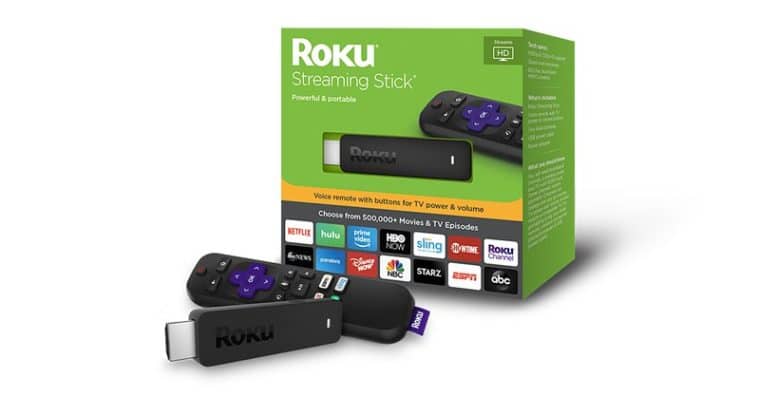
Netflix Sales Data
Year (Q1)
Subscribers (in millions)
2013
34.24
2014
46.13
2015
59.62
2016
77.71
2017
94.36
2018
118.9
2019
148.86
2020
182.86
2021
207.64
2022
221.64
2023
232.5
Netflix Product Stats
DVD Delivery Era Data
Netflix Self-Produced Content
Netflix Title
Hours Watched
Squid Game (season 1)
1.65 billion
Stranger Things (season 4)
1.35 billion
Wednesday (season 1)
1.24 billion
Dahmer
856.2 million
Money Heist (part 5)
792.2 million
Bridgerton (season 2)
656.3 million
Bridgerton (season 1)
625.5 million
Money Heist (part 4)
619 million
Stranger Things (season 3)
582.1 million
Lucifer (season 5)
569.5 million
All of Us Are Dead
560.8 million
The Witcher (season 1)
541 million
Inventing Anna
511.9 million
Ginny & Georgia (season 2)
504.8 million
Netflix Top Titles Per Category
Top English Language Movies on Netflix
- Red Notice
- Don’t Look Up
- The Adam Project
- Bird Box
- The Gray Man
- We Can Be Heroes
- Glass Onion: A Knives Out Mystery
- Extraction
- Spenser Confidential
- The Mother
Top Non-English Language Movies on Netflix
- Troll
- The Platform
- Through My Window
- Blood Red Sky
- AKA
- My Name is Vendetta
- Black Crab
- All Quiet on the Western Front
- Below Zero
- Loving Adults
Top English Language TV Series on Netflix
- Wednesday: Season 1
- Stranger Things 4
- Dahmer
- Bridgerton: Season 1
- The Queen’s Gambit: Limited Series
- The Night Agent: Season 1
- Stranger Things 3
- Bridgerton: Season 2
- The Witcher: Season 1
- The Watcher: Season 1
Top Non-English Language TV Series on Netflix
- Squid Game: Season 1
- Money Heist: Part 4
- Lupin: Part 1
- Money Heist: Part 5
- Money Heist: Part 3
- Lupin: Part 2
- Who Killed Sara?: Season 1
- All of Us Are Dead: Season 1
- Elite: Season 3
- Elite Season 4
Netflix Self-Produced Content Controversy
In 2019, Netflix removed a graphic scene from its self-produced show “13 Reasons Why” after a study had associated the series with an increase in suicide rates.
The scene, depicting a teenage girl taking her own life, has been deleted from the episode, more than two years after its initial premiere.
The film “Cuties,” which explores the sexualization of young girls, faced controversy for its promotional materials and some scenes depicting explicit content involving minors.
While Netflix apologized, the controversy led to widespread public criticism and calls for boycotting Netflix.
The Singaporean government implemented age restrictions on certain LGBTQ+-themed content produced by Netflix, citing concerns about traditional values and societal norms.
This restriction continues even though the country legalized same-sex relationships in 2022.
Netflix Subscription Tiers
In the United States, Netflix offers users four different plan options:
| Plan | Price | Features |
| Standard with ads | $6.99/month |
|
| Basic | $9.99/month |
|
| Standard | $15.49/month |
|
| Premium | $19.99/month |
|
Netflix History & Timeline
- 1997: Netflix is founded by Reed Hastings and Marc Randolph as a DVD rental-by-mail service.
- 1998: Netflix launches its website, offering online movie selection and DVD rental subscriptions.
- 1999: Monthly subscription plans are introduced, allowing subscribers to rent DVDs without late fees.
- 2000: Netflix proposes a partnership with Blockbuster, but the offer is declined.
- 2001: Netflix reaches 456,000 subscribers.
- 2002: Netflix goes public, listing its shares on the NASDAQ stock exchange.
- 2003: Netflix is granted a patent by the US Patent & Trademark Office to protect its subscription rental services, coinciding with the company’s membership exceeding 1 million users.
- 2004: Netflix reveals a 73% year-over-year increase in subscriber growth for the third quarter.
- 2005: Netflix introduces the Profiles feature, enabling members to create separate lists for different users or various moods.
- 2006: Netflix’s number of subscribers reaches 5 million.
- 2007: Netflix launches its streaming service, marking a significant shift towards digital content delivery.
- 2008: Netflix collaborates with consumer electronics brands to enable streaming on Xbox 360, Blu-ray players, and TV set-top boxes.
- 2009: After three years and 40,000 submissions, the $1 million Netflix Prize is awarded to Bellkor’s Pragmatic Chaos team, made up of seven engineers, for improving recommendation accuracy by 10%.
- 2010: Netflix makes its debut in Canada, and the streaming service is launched on mobile devices.
- 2011: Netflix is introduced in Latin America and the Caribbean, accompanied by the debut of the first Netflix button on remote controls.
- 2012: Netflix’s membership soars to 25 million as it expands its services into the United Kingdom, Ireland, and the Nordic countries.
- 2013: Netflix establishes itself as a content creator with its first original releases, including “House of Cards”, “Hemlock Grove”, Arrested Development”, and “Orange is the New Black”.
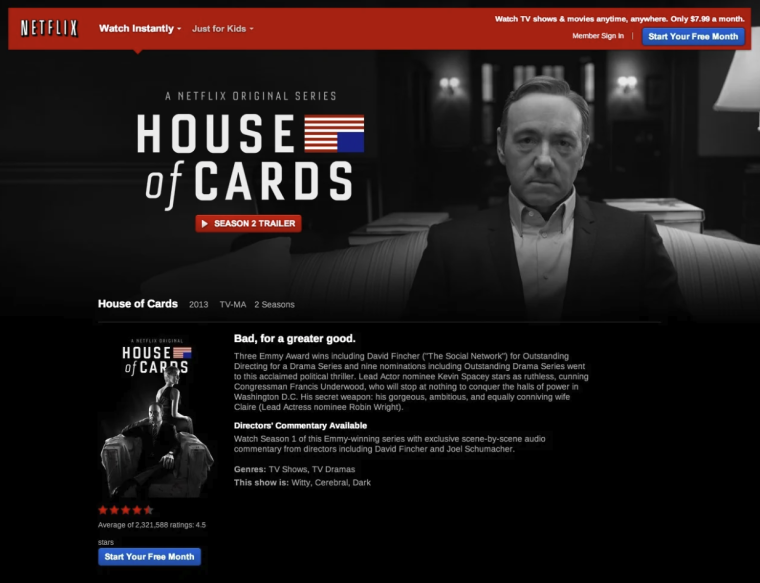
- 2014: Netflix achieves a milestone with membership exceeding 50 million and expands its reach to Austria, Belgium, France, Germany, Luxembourg, and Switzerland.
- 2015: Netflix introduces its inaugural original feature film, “Beasts of No Nation”, along with its first non-English original series, “Club de Cuervos”, and its first Asian original, “Terrace House”.
- 2016: The company announces a global expansion, making its streaming service available in over 190 countries and 21 languages.
- 2017: Netflix surpasses 100 million subscribers worldwide.
- 2018: Netflix secures the position as the most-nominated studio at the Emmys®, triumphing with a total of 23 wins for acclaimed series such as “GLOW”, “Godless”, and “Queer Eye”.
- 2019: Netflix faces competition as other streaming services enter the market, such as Disney+ and Apple TV+.
- 2020: Netflix introduces the feature of Top 10 lists, enabling members to discover what’s popular for the first time.
- 2021: Netflix achieves a milestone with membership surpassing 200 million, while also introducing the launch of mobile games.
- 2022: Netflix introduces an ad-supported tier to counter losses in its subscriber base. The Basic with Ads plan becomes available in 12 countries, including Australia, Brazil, Canada, France, Germany, Italy, Japan, Korea, Mexico, Spain, the UK, and the United States.
- 2023: Netflix secures six wins at the Academy Awards for various titles, including ‘The Elephant Whisperers”, “Guillermo del Toro’s Pinocchio”, and “All Quiet on the Western Front”.
Netflix continues to invest heavily in original content production, securing deals with prominent creators, studios, and talent, aiming to provide a diverse range of entertainment options to its subscribers.
Netflix Demographics
Netflix is offered in over 37 languages across 190 countries worldwide.
Netflix has offices in over 28 cities worldwide, including major locations such as Los Angeles, New York, London, Paris, Tokyo, Sydney, Mumbai, and Sao Paulo.
The majority of Netflix’s subscriber base, with over 77 million subscribers, is concentrated in the EMEA region (Europe, Middle East, and Africa).
In the United States, more Hispanic (21%) and African Americans (29%) watch Netflix multiple times daily compared to Caucasians (13%).
A 2022 survey revealed that Netflix has higher popularity among younger consumers in the United States than among older generations, with 75% of respondents between ages 18-34 reporting that they have a subscription.
The survey findings indicate that approximately 44% of individuals aged 65 or older are subscribed to Netflix.
Slovakia boasted the world’s largest Netflix content selection, with over 8,400 titles to choose from.
European nations dominated the top 10 list for the most extensive Netflix libraries, including:
- Bulgaria
- Latvia
- Estonia
- Iceland
- Lithuania
- Romania
- UK
- Portugal
- Ireland
- Spain
Netflix Business Data
Reed Hastings, co-founder of Netflix, served as CEO from the company’s inception in 1998 until becoming the co-CEO in 2020.
Hastings stepped down into the role of Executive Chairman in 2023. As of 2023, Ted Sarandos and Greg Peters both serve as co-CEOs of Netflix.
| Headquarters | Las Gatos, California, United States |
| Number of Employees | 10,001+ |
| Private or Public | Public |
| Crunchbase (CB) Rank | 7 |
| Number of Acquisitions | 9 |
| Total Products Active | 79 |
| Monthly Visits | 1,044,542,003 |
| Monthly Visits Growth | 0.52% |
Netflix relies on cloud computing services provided by companies like Amazon Web Services (AWS).
AWS hosts Netflix’s streaming infrastructure, ensuring scalability and availability for its global user base.
In 2023, Netflix plans to invest $1.9 billion in local content, which accounts for 47% of its revenue.
Netflix launched 29 exclusive Korean dramas in 2022, with six of them ranking among the top 10 most-watched titles in APAC (Asia-Pacific) during the same year.
In April 2023, Netflix announced its commitment to invest $2.5 billion in South Korea over the next four years.
This investment will be dedicated to producing Korean TV series, movies, and unscripted shows, effectively doubling the company’s investment in the market since 2016.
Netflix Competitor Stats
Disney Plus
Disney Plus, launched in November 2019, offers a wide range of content from the Disney, Marvel, Star Wars, and National Geographic franchises.
In the first quarter of 2023, Disney+ had 161.8 million subscribers, compared to Netflix’s 232.5 million in the same quarter.
Netflix has a broader range of content, including original series and movies across various genres, while Disney Plus primarily focuses on family-friendly content.
HBO Max
HBO launched its standalone streaming service called HBO Max in May 2020.
HBO Max is only available in the United States, whereas Netflix is available in 190 countries.
In the first quarter of 2022, HBO and HBO Max had 48.6 million subscribers combined. In the same quarter, Netflix had 74.58 million subscribers in the US, and 221.64 million subscribers worldwide.
Hulu
Hulu, launched in 2007, is a streaming service primarily focused on offering next-day access to recent episodes of current TV series. They also have an extensive library of movies and series, including a range of Hulu original series.
As of Q1 2023, Hulu had 48 million subscribers. In comparison, Netflix had 232.5 million subscribers during the same quarter.
Hulu primarily operates in the United States, while Netflix offers its service in 190 countries.
Amazon
Amazon Prime Video, a service provided to Amazon Prime members since 2006, includes thousands of movies and TV episodes, including award-winning Amazon Originals.
Amazon Prime Video is available in more than 200 countries and territories, giving it a wider reach than Netflix.
Amazon’s Prime Video holds the dominant position in the streaming market in Japan, but Netflix maintains a strong presence and continues to expand its catalog with a growing collection of anime and other original content.
Amazon Prime Video is bundled with the Amazon Prime membership ($14.99 per month), which includes additional benefits like free two-day shipping on eligible items, access to Prime Music, and more. Netflix offers various subscription plans at different price points, ranging from basic to premium tiers.
Peacock
Peacock, launched by NBCUniversal in July 2020, offers a mix of current series, movies, news, sports, and pop culture highlights, in addition to original programming.
As of Q1 2023, Peacock had 21 million paid subscribers in the United States, whereas Netflix had 74.4 million paying subscribers.
Peacock is available in the United States only, in contrast to Netflix’s global presence.
Apple TV Plus
Apple TV Plus, launched in November 2019, focuses on original content, including movies, series, and documentaries.
As of Q1 2023, Apple TV Plus had an estimated 42.1 million subscribers, a fraction of Netflix’s 232.5 million subscribers in the same period.
Apple TV Plus is available in over 100 countries, compared to Netflix’s availability in 190 countries.
YouTube TV
YouTube TV, launched by Google in 2017, offers live TV from over 85 networks, including local sports and news. Unlike Netflix, it primarily focuses on live and on-demand TV, rather than on original content.
YouTube TV is only available in the United States, limiting its direct competition with Netflix’s global reach.
Netflix Fun Facts
- Globally, the most used Netflix profile icon is Boss Baby, with 11 million profiles using it.
- Contrary to the iconic red envelopes associated with Netflix, the first DVD envelope used by the company was actually white.
- A dedicated Netflix fan showcased their creativity by crafting a dress made out of an astonishing 1,500 DVD envelopes.
- The show Money Heist is on the most subscribers MyList Adds.
- The most “secret codes” on the platform at one time was 70,000, today it has 30,000 (codes give access to hidden TV series and movies).
- Netflix’s orginal name was Kibble.
- Chess board sales saw a 125% increase in sales after the release of The Queen’s Gambit.
- The word “binge-watch” was declared word of the year in 2017.
- The Twitter account “NoFaceNina” (La Shanda Rene Foster) was the first recorded person to use the term “Netflix and chill” in 2009.
- Ben & Jerry’s offers an ice cream flavor called “Netflix & Chill’d”
- Netflix’s most popular title of all time is Squid Game, with 1.65 billion hours of viewing in 28 days following its premier.
- The idea for Netflix came to Reed Hastings after he was charged $40 in late fees for a Blockbuster rental of the movie “Apollo 13”.
- Netflix users created a website called “The Bingeclock,” which calculates the total runtime of a TV series and tells you how many days, hours, and minutes it would take to binge-watch it.
- One notable April Fools prank was the introduction of “Netflix Live,” a streaming channel featuring actor Will Arnett making random comments about mundane activities like sitting at a desk or eating macaroni and cheese.
- Netflix created a do-it-yourself project called “The Netflix Socks”. These special socks detect when you fall asleep and pause the show you’re watching so you don’t miss anything while dozing off.
Resources
- Yahoo Finance
- CNN
- Reuters
- CNBC
- Crunchbase
- Statista
- Statista
- BBC
- Netflix
- Statista
- Wired
- Fortune
- Variety
- History
- NYTimes
- Global News
- Variety
- Netflix
- Newsweek
- Statista
- Polygon
- Statista
- Statista
- Statista
- The Guardian
- Variety
- Reuters
- Statista
- Statista
- Statista
- Video Central
- Variety
- Statista
- Statista
- Apple
- CNBC
- Quartz
